Extension of an Open GEOBIA Framework for Spatially Explicit Forest Stratification with Sentinel-2
Abstract
:1. Introduction
- Can multi-temporal MR satellite data compensate for the inadequacies of VHR aerial imagery (acquisition time and frequency, shadow cast in the imagery, spectral resolution), while still maintaining the spatial detail aerial imagery delivers towards image objects?
- Is Sentinel-2 able to improve leaf type classification compared with aerial imagery, which is temporally non-uniformly acquired and does not cover phenologically optimal dates?
- What is the optimal temporal setup of Sentinel-2 acquisition dates for receiving reliable updates for leaf type stratification?
2. Materials and Methods
2.1. Study Area
2.2. Data
2.2.1. Aerial Imagery
2.2.2. OpenStreetMap
2.2.2.1. sBoundaries for Segmentation
2.2.2.2. Training Data
2.2.3. Sentinel-2
2.3. Methodology
2.3.1. Region Growing Segmentation
2.3.2. Random Forest Classification
2.3.3. Validation via Reference Map
3. Results
3.1. Region Growing Segmentation with USPO
3.2. Classification in Different Setups
3.2.1. Single-Date Sentinel-2 Classifications
3.2.2. Multi-Temporal Sentinel-2 Classifications
3.2.3. Classifications Based on Index Time Series
3.2.4. Reevaluating Classifications Based on Aerial Imagery of 2020
4. Discussion
4.1. Image Objects and Their Influence on Classification
4.2. Sentinel-2 as (Multi-Temporal) Input Data
4.3. Temporal Inconsistencies
4.4. Validation via Reference Map
5. Conclusions
Author Contributions
Funding
Data Availability Statement
Acknowledgments
Conflicts of Interest
Appendix A
| Sentinel-2 Scene | Sensor | Acquisition Date | OAA (%) |
|---|---|---|---|
| S1 (10) | Sentinel-2 A | 28 March 2020 | 86.5 |
| S2 (10) | Sentinel-2 A | 7 April 2020 | 85.7 |
| S3 (10) | Sentinel-2 B | 22 April 2020 | 88.3 |
| S4 (10) | Sentinel-2 A | 7 May 2020 | 88.2 |
| S5 (10) | Sentinel-2 A | 17 May 2020 | 88.0 |
| S6 (10) | Sentinel-2 A | 27 May 2020 | 86.2 |
| S7 (10) | Sentinel-2 B | 31 July 2020 | 87.0 |
| S8 (10) | Sentinel-2 A | 5 August 2020 | 84.9 |

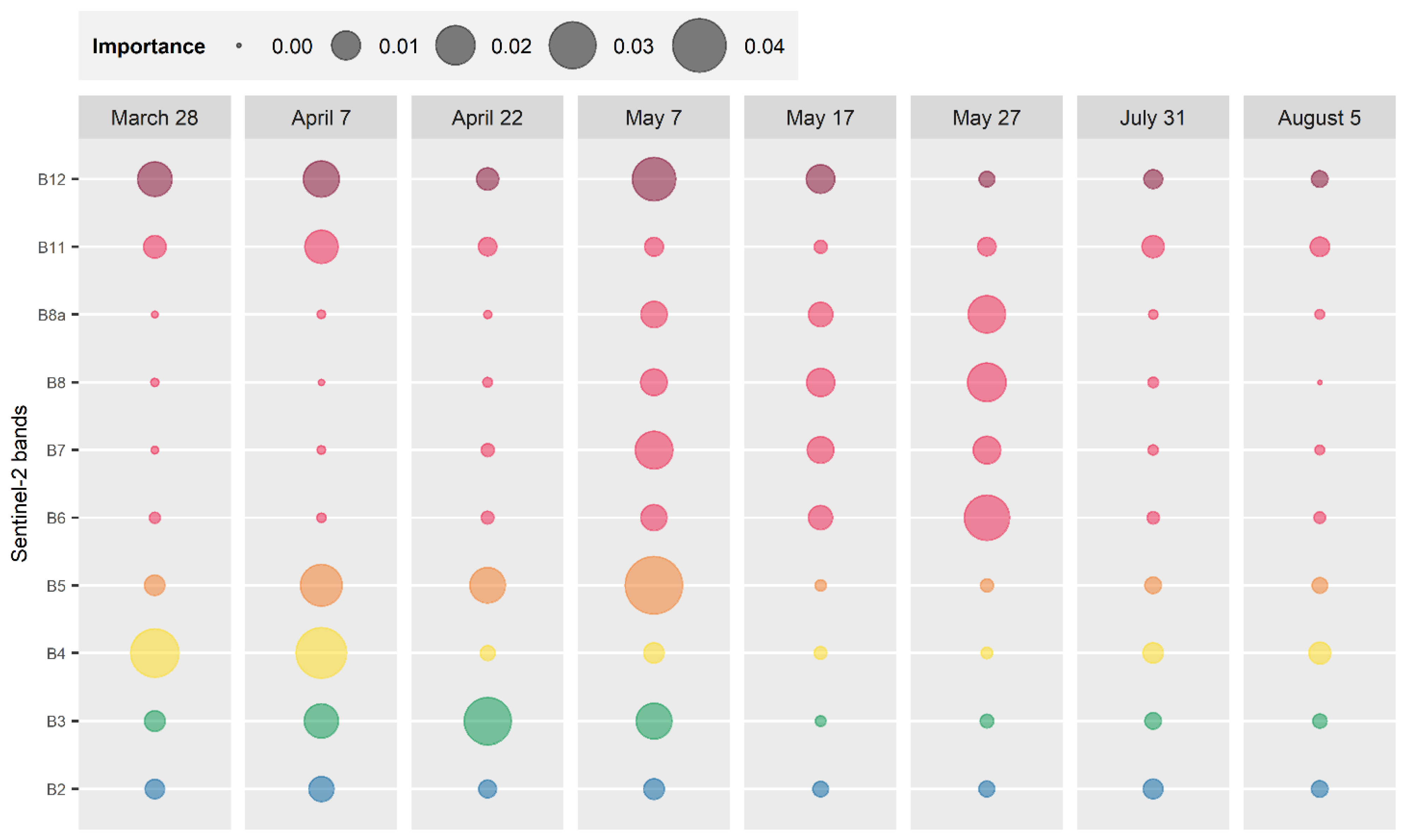
References
- Immitzer, M.; Vuolo, F.; Atzberger, C. First Experience with Sentinel-2 Data for Crop and Tree Species Classifications in Central Europe. Remote Sens. 2016, 8, 166. [Google Scholar] [CrossRef]
- Hemmerling, J.; Pflugmacher, D.; Hostert, P. Mapping temperate forest tree species using dense Sentinel-2 time series. Remote Sens. Environ. 2021, 267, 112743. [Google Scholar] [CrossRef]
- Boyd, D.; Danson, F. Satellite remote sensing of forest resources: Three decades of research development. Prog. Phys. Geogr. 2005, 29, 1–26. [Google Scholar] [CrossRef]
- Defries, R.S.; Hansen, M.C.; Townshend, J.R.; Janetos, A.; Loveland, T.R. A new global 1-km dataset of percentage tree cover derived from remote sensing. Glob. Chang. Biol. 2000, 6, 247–254. [Google Scholar] [CrossRef]
- Nink, S.; Hill, J.; Stoffels, J.; Buddenbaum, H.; Frantz, D.; Langshausen, J. Using Landsat and Sentinel-2 Data for the Generation of Continuously Updated Forest Type Information Layers in a Cross-Border Region. Remote Sens. 2019, 11, 2337. [Google Scholar] [CrossRef] [Green Version]
- Holzwarth, S.; Thonfeld, F.; Abdullahi, S.; Asam, S.; Da Ponte Canova, E.; Gessner, U.; Huth, J.; Kraus, T.; Leutner, B.; Kuenzer, C. Earth Observation Based Monitoring of Forests in Germany: A Review. Remote Sens. 2020, 12, 3570. [Google Scholar] [CrossRef]
- Hościło, A.; Lewandowska, A. Mapping Forest Type and Tree Species on a Regional Scale Using Multi-Temporal Sentinel-2 Data. Remote Sens. 2019, 11, 929. [Google Scholar] [CrossRef] [Green Version]
- Grabska, E.; Hostert, P.; Pflugmacher, D.; Ostapowicz, K. Forest Stand Species Mapping Using the Sentinel-2 Time Series. Remote Sens. 2019, 11, 1197. [Google Scholar] [CrossRef] [Green Version]
- Kowalski, K.; Senf, C.; Hostert, P.; Pflugmacher, D. Characterizing spring phenology of temperate broadleaf forests using Landsat and Sentinel-2 time series. Int. J. Appl. Earth Obs. Geoinf. 2020, 92, 102172. [Google Scholar] [CrossRef]
- Löw, M.; Koukal, T. Phenology Modelling and Forest Disturbance Mapping with Sentinel-2 Time Series in Austria. Remote Sens. 2020, 12, 4191. [Google Scholar] [CrossRef]
- Stoffels, J.; Hill, J.; Sachtleber, T.; Mader, S.; Buddenbaum, H.; Stern, O.; Langshausen, J.; Dietz, J.; Ontrup, G. Satellite-Based Derivation of High-Resolution Forest Information Layers for Operational Forest Management. Forests 2015, 6, 1982–2013. [Google Scholar] [CrossRef]
- Symbios Spazio, U.K. ESA’s Earth Observation Third Party Missions. Available online: https://earth.esa.int/c/document_library/get_file?folderId=13019&name=DLFE-744.pdf (accessed on 8 November 2021).
- Maxwell, A.E.; Strager, M.P.; Warner, T.A.; Ramezan, C.A.; Morgan, A.N.; Pauley, C.E. Large-Area, High Spatial Resolution Land Cover Mapping Using Random Forests, GEOBIA, and NAIP Orthophotography: Findings and Recommendations. Remote Sens. 2019, 11, 1409. [Google Scholar] [CrossRef] [Green Version]
- Ganz, S.; Adler, P.; Kändler, G. Forest Cover Mapping Based on a Combination of Aerial Images and Sentinel-2 Satellite Data Compared to National Forest Inventory Data. Forests 2020, 11, 1322. [Google Scholar] [CrossRef]
- Fassnacht, F.E.; Latifi, H.; Stereńczak, K.; Modzelewska, A.; Lefsky, M.; Waser, L.T.; Straub, C.; Ghosh, A. Review of studies on tree species classification from remotely sensed data. Remote Sens. Environ. 2016, 186, 64–87. [Google Scholar] [CrossRef]
- Hollaus, M.; Vreugdenhil, M. Radar satellite imagery for detecting bark beetle outbreaks in forests. Curr. For. Rep. 2019, 5, 240–250. [Google Scholar] [CrossRef] [Green Version]
- Bae, S.; Müller, J.; Förster, B.; Hilmers, T.; Hochrein, S.; Jacobs, M.; Leroy, B.M.; Pretzsch, H.; Weisser, W.W.; Mitesser, O. Tracking the temporal dynamics of insect defoliation by high-resolution radar satellite data. Methods Ecol. Evol. 2021, 13, 121–132. [Google Scholar] [CrossRef]
- Stoffels, J.; Mader, S.; Hill, J.; Werner, W.; Ontrup, G. Satellite-based stand-wise forest cover type mapping using a spatially adaptive classification approach. Eur. J. For. Res. 2011, 131, 1071–1089. [Google Scholar] [CrossRef]
- Brauchler, M.; Stoffels, J. Leveraging OSM and GEOBIA to Create and Update Forest Type Maps. ISPRS Int. J. Geo Inf. 2020, 9, 499. [Google Scholar] [CrossRef]
- Blaschke, T.; Hay, G.J.; Kelly, M.; Lang, S.; Hofmann, P.; Addink, E.; Queiroz Feitosa, R.; van der Meer, F.; van der Werff, H.; van Coillie, F.; et al. Geographic Object-Based Image Analysis—Towards a new paradigm. ISPRS J. Photogramm. Remote Sens. 2014, 87, 180–191. [Google Scholar] [CrossRef] [Green Version]
- UNFCCC. Report of the Conference of the Parties on Its Seventh Session, Held at Marrakesh from 29 October to 10 November 2001 (FCCC/CP/2001/13/Add.1, UNFCCC, Marrakesh, Morocco, 2001). 2002. Available online: https://unfccc.int/documents/2517 (accessed on 10 November 2019).
- Probeck, M.; Ramminger, G.; Herrmann, D.; Gomez, S.; Häusler, T. European Forest Monitoring Approaches. In Land Use and Land Cover Mapping in Europe; Springer: Berlin/Heidelberg, Germany, 2014; pp. 89–114. [Google Scholar]
- Oreti, L.; Giuliarelli, D.; Tomao, A.; Barbati, A. Object Oriented Classification for Mapping Mixed and Pure Forest Stands Using Very-High Resolution Imagery. Remote Sens. 2021, 13, 2508. [Google Scholar] [CrossRef]
- Administration des Ponts et Chaussées Service Géologique. Portail Luxembourgeois des Sciences de la Terre. Available online: http://www.geologie.lu/ (accessed on 25 August 2021).
- Le Gouvernement du Grand-douché de Luxembourg. The Luxembourgish Data Platform. Available online: https://data.public.lu/ (accessed on 21 May 2020).
- Ministère de L’environnement du Climat et du Développement Durable. Strategie und Aktionsplan für die Anpassung an den Klimawandel in Luxembourg 2018–2023. Available online: https://environnement.public.lu/content/dam/environnement/documents/klima_an_energie/Anpassungsstrategie-Klimawandel-Clean.pdf (accessed on 28 August 2021).
- Rondeux, J.; Alderweireld, M.; Saidi, M.; Schillings, T.; Freymann, E.; Murat, D.; Kugener, G. La Forêt Luxembourgeoise en Chiffres-Résultats de l’Inventaire Forestier National au Grand-Duché de Luxembourg 2009–2011; Administration de la Nature et des Forêts du Grand-Duché de Luxembourg—Service des Forêts: Luxembourg, 2014.
- Niemeyer, T.; Härdtle, W.; Ries, C. Die Waldgesellschaften Luxemburgs: Vegetation, Standort, Vorkommen und Gefährdung; Musée National D’histoire Naturelle: Luxembourg, 2010. [Google Scholar]
- Frantz, D. FORCE—Landsat + Sentinel-2 Analysis Ready Data and Beyond. Remote Sens. 2019, 11, 1124. [Google Scholar] [CrossRef] [Green Version]
- act.public.lu. Photos Aériennes. Available online: https://act.public.lu/fr/cartographie/photos-aeriennes.html (accessed on 22 July 2020).
- data.public.lu. Orthophoto Officelle du Grand-Duché de Luxembourg, Edition 2018. Available online: https://data.public.lu/fr/datasets/orthophoto-officelle-du-grand-duche-de-luxembourg-edition-2018/ (accessed on 10 November 2019).
- data.public.lu. Orthophoto Officelle du Grand-Duché de Luxembourg, Edition 2020. Available online: https://data.public.lu/fr/datasets/orthophoto-officielle-du-grand-duche-de-luxembourg-edition-2020/ (accessed on 1 July 2021).
- Arsanjani, J.J.; Mooney, P.; Zipf, A.; Schauss, A. Quality Assessment of the Contributed Land Use Information from Openstreetmap Versus Authoritative Datasets. In OpenStreetMap in GIScience; Springer: Berlin/Heidelberg, Germany, 2015; pp. 37–58. [Google Scholar]
- Mooney, P.; Corcoran, P.; Winstanley, A. A study of Data Representation of Natural Features in Openstreetmap. In Proceedings of the GIScience, Zurich, Switzerland, 14–17 September 2010; pp. 150–156. [Google Scholar]
- Mooney, P.; Corcoran, P. Has OpenStreetMap a role in Digital Earth applications? Int. J. Digit. Earth 2013, 7, 534–553. [Google Scholar] [CrossRef] [Green Version]
- Jaccard, P. Distribution de la flore alpine dans le bassin des Dranses et dans quelques régions voisines. Bull. Soc. Vaud. Sci. Nat. 1901, 37, 241–272. [Google Scholar]
- Korzeniowska, K. Mapping Land Use 2018 in Luxembourg: An Approach Based on Aerial Images, LiDAR and Ancillary GIS Data (Version I1.0). Available online: https://download.data.public.lu/resources/lis-l-land-use-2007-2015-2018/20210308-145903/lisl-landuse-2018-documentation.pdf (accessed on 12 August 2021).
- Fewster, R.; Buckland, S. Similarity indices for spatiaI ecological data. Biometrics 2001, 57, 495–501. [Google Scholar] [CrossRef]
- Raifer, M. Overpass Turbo—Overpass API. Available online: http://overpass-turbo.eu/ (accessed on 15 January 2020).
- Neis, P. Statistics of the Free Wiki World Map (OpenStreetMap.org)—Edits of Luxembourg. Available online: https://osmstats.neis-one.org/?item=countries&country=Luxembourg (accessed on 7 May 2021).
- data.public.lu. Luxembourg’s Orthoimagery and Maps for OSM Editors. Available online: https://data.public.lu/en/reuses/luxembourgs-orthoimagery-and-maps-for-osm-editors/ (accessed on 28 April 2020).
- Smith, G.M.; Morton, R.D. Real world objects in GEOBIA through the exploitation of existing digital cartography and image segmentation. Photogramm. Eng. Remote Sens. 2010, 76, 163–171. [Google Scholar] [CrossRef]
- Johnson, B.A.; Iizuka, K. Integrating OpenStreetMap crowdsourced data and Landsat time-series imagery for rapid land use/land cover (LULC) mapping: Case study of the Laguna de Bay area of the Philippines. Appl. Geogr. 2016, 67, 140–149. [Google Scholar] [CrossRef]
- Schultz, M.; Voss, J.; Auer, M.; Carter, S.; Zipf, A. Open land cover from OpenStreetMap and remote sensing. Int. J. Appl. Earth Obs. Geoinf. 2017, 63, 206–213. [Google Scholar] [CrossRef]
- Fonte, C.C.; Patriarca, J.A.; Minghini, M.; Antoniou, V.; See, L.; Brovelli, M.A. Using OpenStreetMap to Create Land Use and Land Cover Maps: Development of an Application. In Geospatial Intelligence: Concepts, Methodologies, Tools, and Applications; IGI Global: Hershey, PA, USA, 2019; pp. 1100–1123. [Google Scholar]
- Drusch, M.; Del Bello, U.; Carlier, S.; Colin, O.; Fernandez, V.; Gascon, F.; Hoersch, B.; Isola, C.; Laberinti, P.; Martimort, P.; et al. Sentinel-2: ESA’s Optical High-Resolution Mission for GMES Operational Services. Remote Sens. Environ. 2012, 120, 25–36. [Google Scholar] [CrossRef]
- ESA. Copernicus Open Access Hub—Free and Open Data Access. Available online: https://scihub.copernicus.eu/userguide/#Free_and_Open_data_access (accessed on 24 April 2021).
- Tanré, D.; Deroo, C.; Duhaut, P.; Herman, M.; Morcrette, J.; Perbos, J.; Deschamps, P. Technical note Description of a computer code to simulate the satellite signal in the solar spectrum: The 5S code. Int. J. Remote Sens. 1990, 11, 659–668. [Google Scholar] [CrossRef]
- Immitzer, M.; Atzberger, C.; Koukal, T. Tree Species Classification with Random Forest Using Very High Spatial Resolution 8-Band WorldView-2 Satellite Data. Remote Sens. 2012, 4, 2661–2693. [Google Scholar] [CrossRef] [Green Version]
- Aschbacher, J.; Milagro-Pérez, M.P. The European Earth monitoring (GMES) programme: Status and perspectives. Remote Sens. Environ. 2012, 120, 3–8. [Google Scholar] [CrossRef]
- Pasquarella, V.J.; Holden, C.E.; Woodcock, C.E. Improved mapping of forest type using spectral-temporal Landsat features. Remote Sens. Environ. 2018, 210, 193–207. [Google Scholar] [CrossRef]
- Grabska, E.; Frantz, D.; Ostapowicz, K. Evaluation of machine learning algorithms for forest stand species mapping using Sentinel-2 imagery and environmental data in the Polish Carpathians. Remote Sens. Environ. 2020, 251, 112103. [Google Scholar] [CrossRef]
- Immitzer, M.; Neuwirth, M.; Böck, S.; Brenner, H.; Vuolo, F.; Atzberger, C. Optimal Input Features for Tree Species Classification in Central Europe Based on Multi-Temporal Sentinel-2 Data. Remote Sens. 2019, 11, 2599. [Google Scholar] [CrossRef] [Green Version]
- Johnson, B.A.; Ma, L. Image Segmentation and Object-Based Image Analysis for Environmental Monitoring: Recent Areas of Interest, Researchers’ Views on the Future Priorities. Remote Sens. 2020, 12, 1772. [Google Scholar] [CrossRef]
- Hossain, M.D.; Chen, D. Segmentation for Object-Based Image Analysis (OBIA): A review of algorithms and challenges from remote sensing perspective. ISPRS J. Photogramm. Remote Sens. 2019, 150, 115–134. [Google Scholar] [CrossRef]
- Ming, D.; Zhou, W.; Xu, L.; Wang, M.; Ma, Y. Coupling relationship among scale parameter, segmentation accuracy, and classification accuracy in geobia. Photogramm. Eng. Remote Sens. 2018, 84, 681–693. [Google Scholar] [CrossRef]
- Liu, Y.; Gong, W.; Hu, X.; Gong, J. Forest Type Identification with Random Forest Using Sentinel-1A, Sentinel-2A, Multi-Temporal Landsat-8 and DEM Data. Remote Sens. 2018, 10, 946. [Google Scholar] [CrossRef] [Green Version]
- Kim, M.; Madden, M.; Warner, T. Estimation of Optimal Image Object Size for the Segmentation of Forest Stands with Multispectral IKONOS Imagery. In Object-Based Image Analysis; Springer: Berlin/Heidelberg, Germany, 2008; pp. 291–307. [Google Scholar]
- Lennart, M.; GRASS Development Team. Addon i.Segment.uspo. Available online: https://grass.osgeo.org/grass76/manuals/addons/i.segment.uspo.html (accessed on 5 March 2020).
- Momsen, E.; Metz, M.; GRASS Development Team. Addon i.Segment. Available online: https://grass.osgeo.org/grass78/manuals/i.segment.html (accessed on 8 November 2021).
- Momsen, E.; Metz, M.; GRASS Development Team. Addon i.Segment.gsoc. Available online: https://grass.osgeo.org/grass76/manuals/addons/i.segment.gsoc.html (accessed on 5 March 2020).
- Espindola, G.M.; Camara, G.; Reis, I.A.; Bins, L.S.; Monteiro, A.M. Parameter selection for region-growing image segmentation algorithms using spatial autocorrelation. Int. J. Remote Sens. 2007, 27, 3035–3040. [Google Scholar] [CrossRef]
- Johnson, B.; Bragais, M.; Endo, I.; Magcale-Macandog, D.; Macandog, P. Image Segmentation Parameter Optimization Considering Within- and between-Segment Heterogeneity at Multiple Scale Levels: Test Case for Mapping Residential Areas Using Landsat Imagery. ISPRS Int. J. Geo Inf. 2015, 4, 2292–2305. [Google Scholar] [CrossRef] [Green Version]
- Grippa, T.; Lennert, M.; Beaumont, B.; Vanhuysse, S.; Stephenne, N.; Wolff, E. An Open-Source Semi-Automated Processing Chain for Urban Object-Based Classification. Remote Sens. 2017, 9, 358. [Google Scholar] [CrossRef] [Green Version]
- Grippa, T.; Georganos, S.; Lennert, M.; Vanhuysse, S.; Wolff, E. A local Segmentation Parameter Optimization Approach for Mapping Heterogeneous Urban Environments Using VHR Imagery. In Proceedings of the Remote Sensing Technologies and Applications in Urban Environments II, Warsaw, Poland, 11–12 September 2017; p. 104310G. [Google Scholar]
- Breiman, L. Random forests. Mach. Learn. 2001, 45, 5–32. [Google Scholar] [CrossRef] [Green Version]
- Kucharczyk, M.; Hay, G.J.; Ghaffarian, S.; Hugenholtz, C.H. Geographic Object-Based Image Analysis: A Primer and Future Directions. Remote Sens. 2020, 12, 2012. [Google Scholar] [CrossRef]
- Belgiu, M.; Drăguţ, L. Random forest in remote sensing: A review of applications and future directions. ISPRS J. Photogramm. Remote Sens. 2016, 114, 24–31. [Google Scholar] [CrossRef]
- Räsänen, A.; Kuitunen, M.; Tomppo, E.; Lensu, A. Coupling high-resolution satellite imagery with ALS-based canopy height model and digital elevation model in object-based boreal forest habitat type classification. ISPRS J. Photogramm. Remote Sens. 2014, 94, 169–182. [Google Scholar] [CrossRef] [Green Version]
- Silveyra Gonzalez, R.; Latifi, H.; Weinacker, H.; Dees, M.; Koch, B.; Heurich, M. Integrating LiDAR and high-resolution imagery for object-based mapping of forest habitats in a heterogeneous temperate forest landscape. Int. J. Remote Sens. 2018, 39, 8859–8884. [Google Scholar] [CrossRef]
- Dalagnol, R.; Phillips, O.L.; Gloor, E.; Galvão, L.S.; Wagner, F.H.; Locks, C.J.; Aragão, L.E.O.C. Quantifying Canopy Tree Loss and Gap Recovery in Tropical Forests under Low-Intensity Logging Using VHR Satellite Imagery and Airborne LiDAR. Remote Sens. 2019, 11, 817. [Google Scholar] [CrossRef] [Green Version]
- Kim, M.; Madden, M.; Warner, T.A. Forest type mapping using object-specific texture measures from multispectral Ikonos imagery. Photogramm. Eng. Remote Sens. 2009, 75, 819–829. [Google Scholar] [CrossRef] [Green Version]
- Hall-Beyer, M. Practical guidelines for choosing GLCM textures to use in landscape classification tasks over a range of moderate spatial scales. Int. J. Remote Sens. 2017, 38, 1312–1338. [Google Scholar] [CrossRef]
- data.public.lu. LIS-L Land Use 2007, 2015, 2018. Available online: https://data.public.lu/en/datasets/lis-l-land-use-2007-2015-2018/ (accessed on 19 May 2021).
- Olofsson, P.; Foody, G.M.; Herold, M.; Stehman, S.V.; Woodcock, C.E.; Wulder, M.A. Good practices for estimating area and assessing accuracy of land change. Remote Sens. Environ. 2014, 148, 42–57. [Google Scholar] [CrossRef]
- Antoniol, G.; Basco, C.; Ceccarelli, M.; Metz, M.; Lennart, M.; GRASS Development Team. Addon r.Texture. Available online: https://grass.osgeo.org/grass78/manuals/r.texture.html (accessed on 5 March 2020).
- Warrens, M.J. Relative quantity and allocation disagreement measures for category-level accuracy assessment. Int. J. Remote Sens. 2015, 36, 5959–5969. [Google Scholar] [CrossRef]
- Räsänen, A.; Rusanen, A.; Kuitunen, M.; Lensu, A. What makes segmentation good? A case study in boreal forest habitat mapping. Int. J. Remote Sens. 2013, 34, 8603–8627. [Google Scholar] [CrossRef]
- Smith, G.; Morton, D. Segmentation: The Achilles’ Heel of Object–Based Image Analysis? In Proceedings of the GEOBIA 2008—Pixels, Objects, Intelligence GEOgraphic Object Based Image Analysis for the 21st Century, Calgary, AB, Canada, 5–8 August 2008. [Google Scholar]

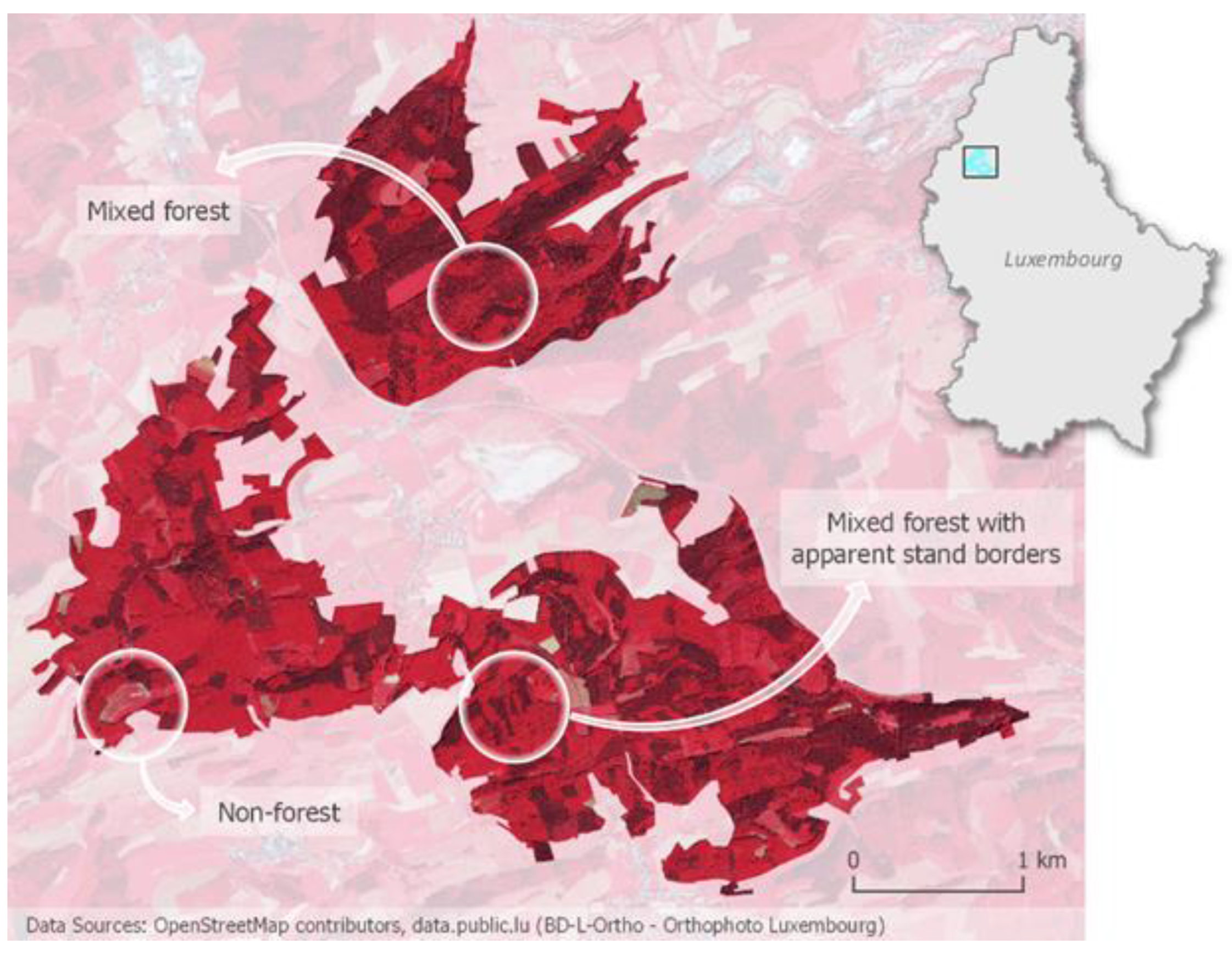
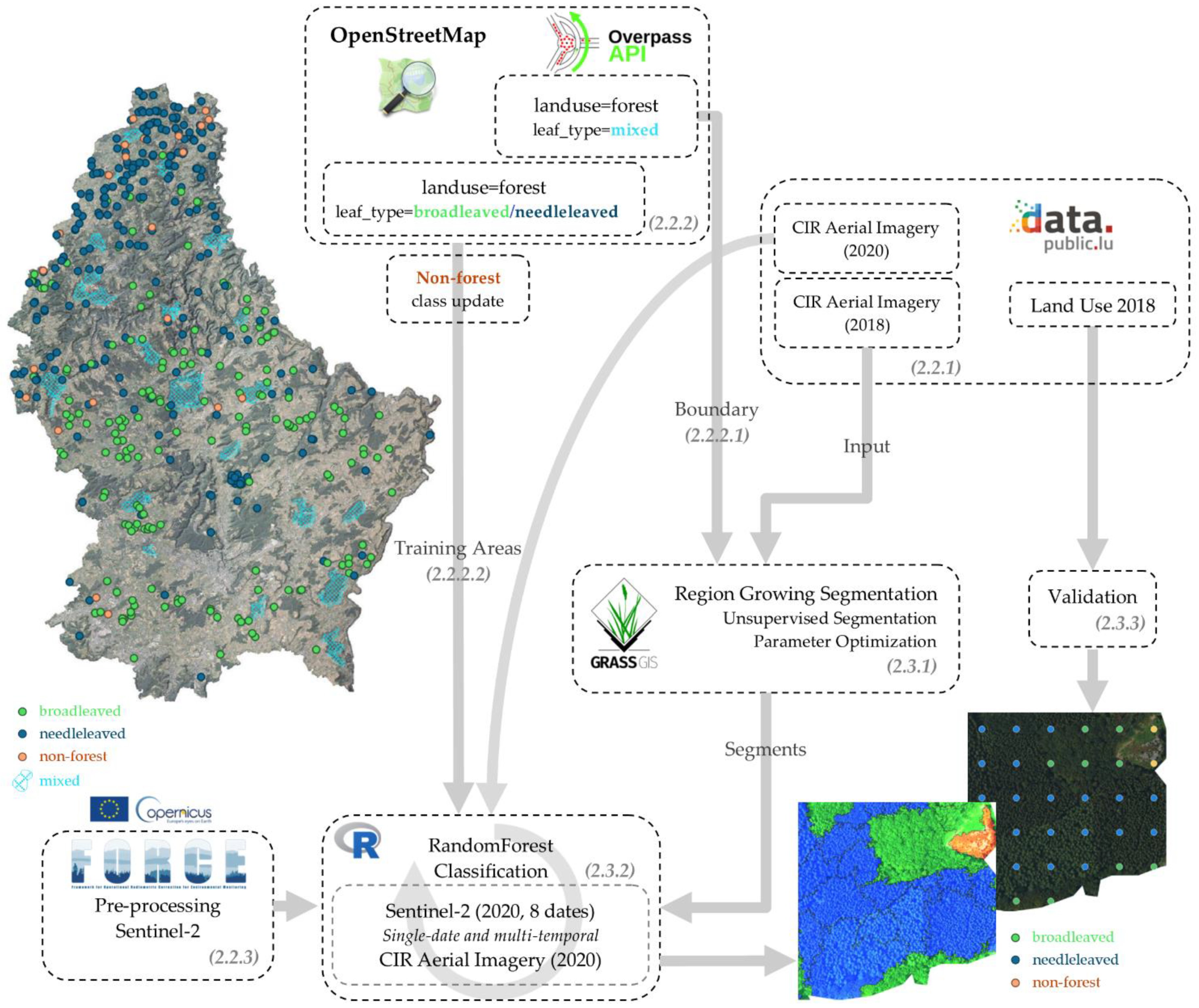
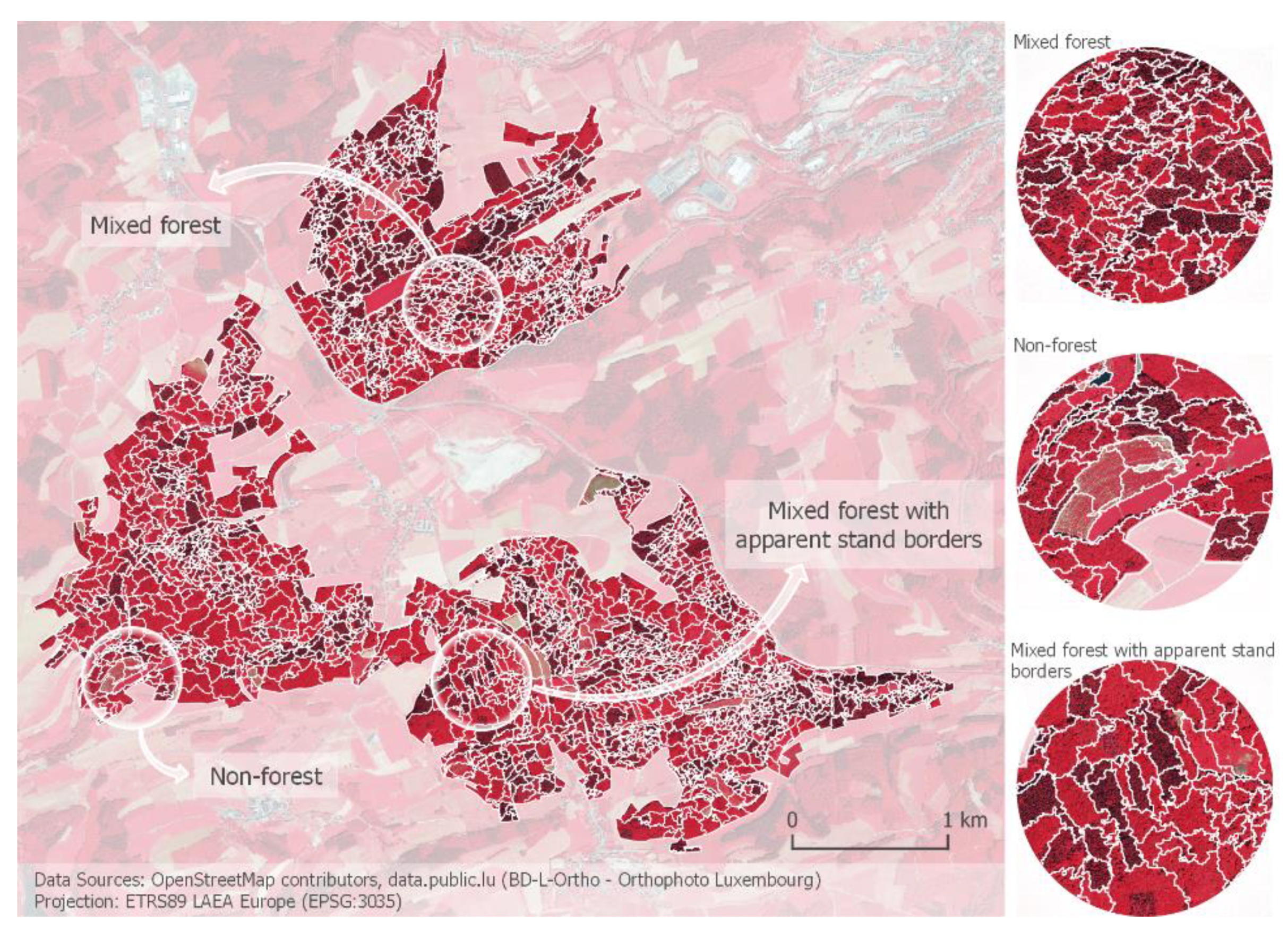



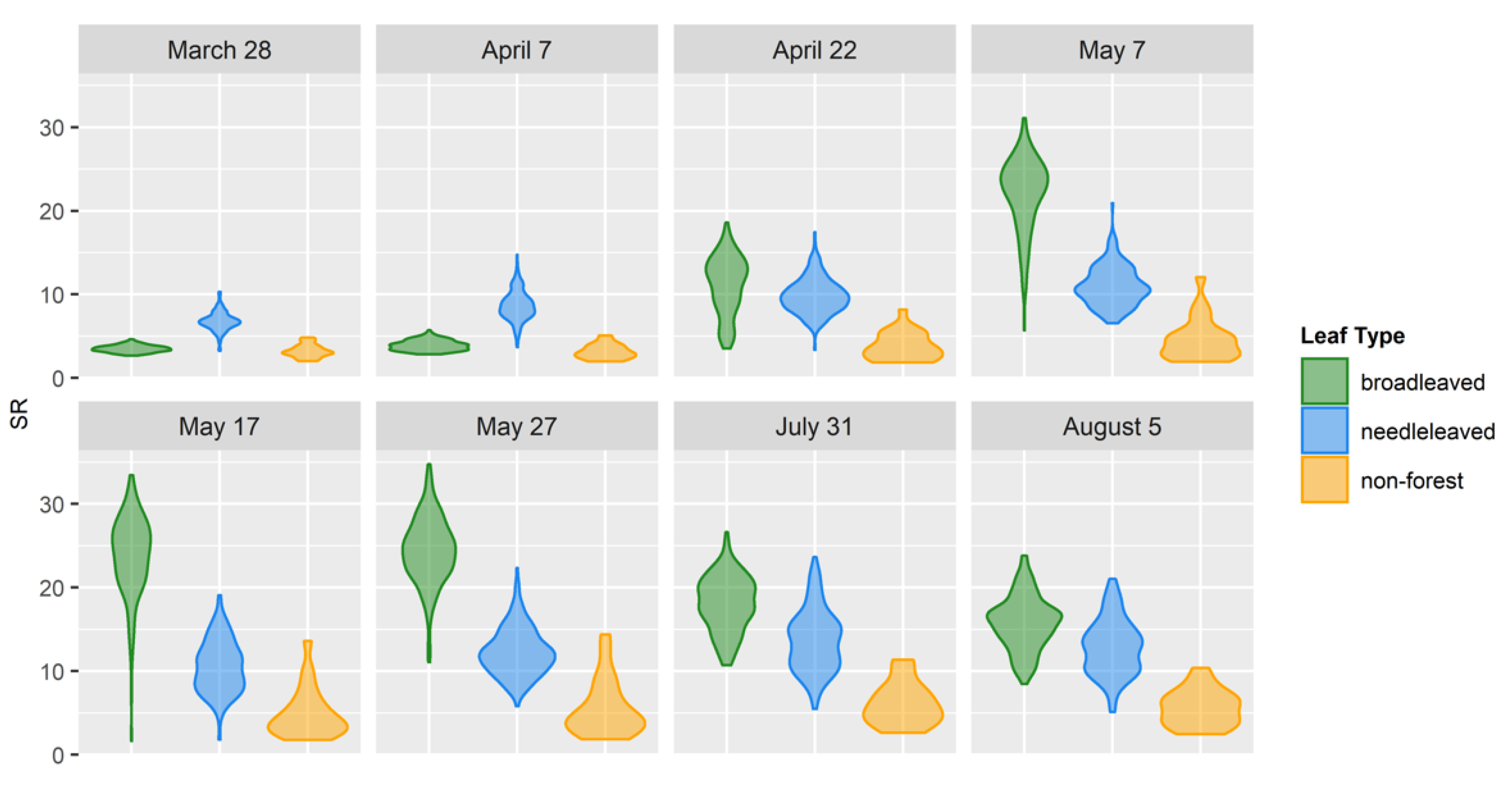
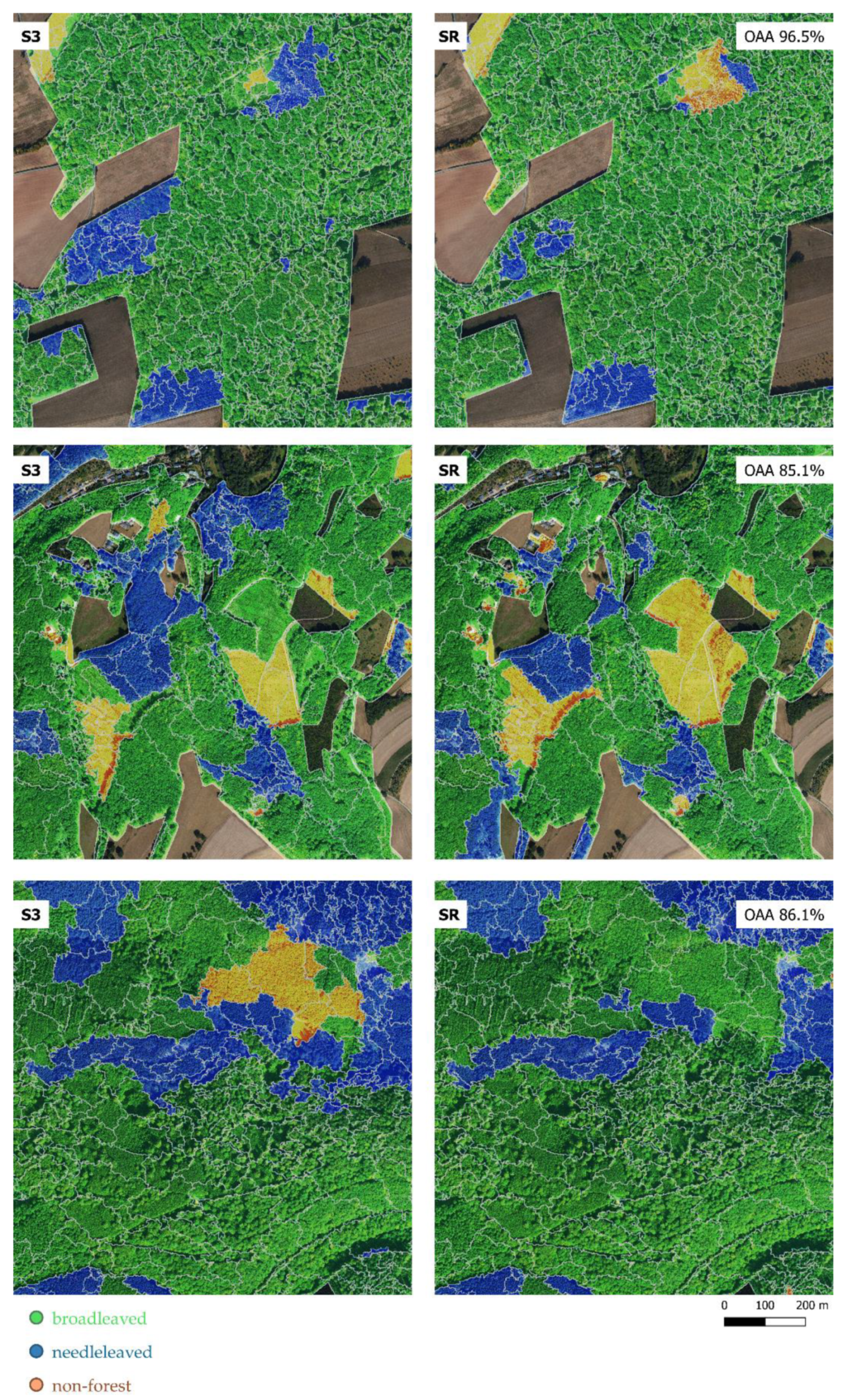

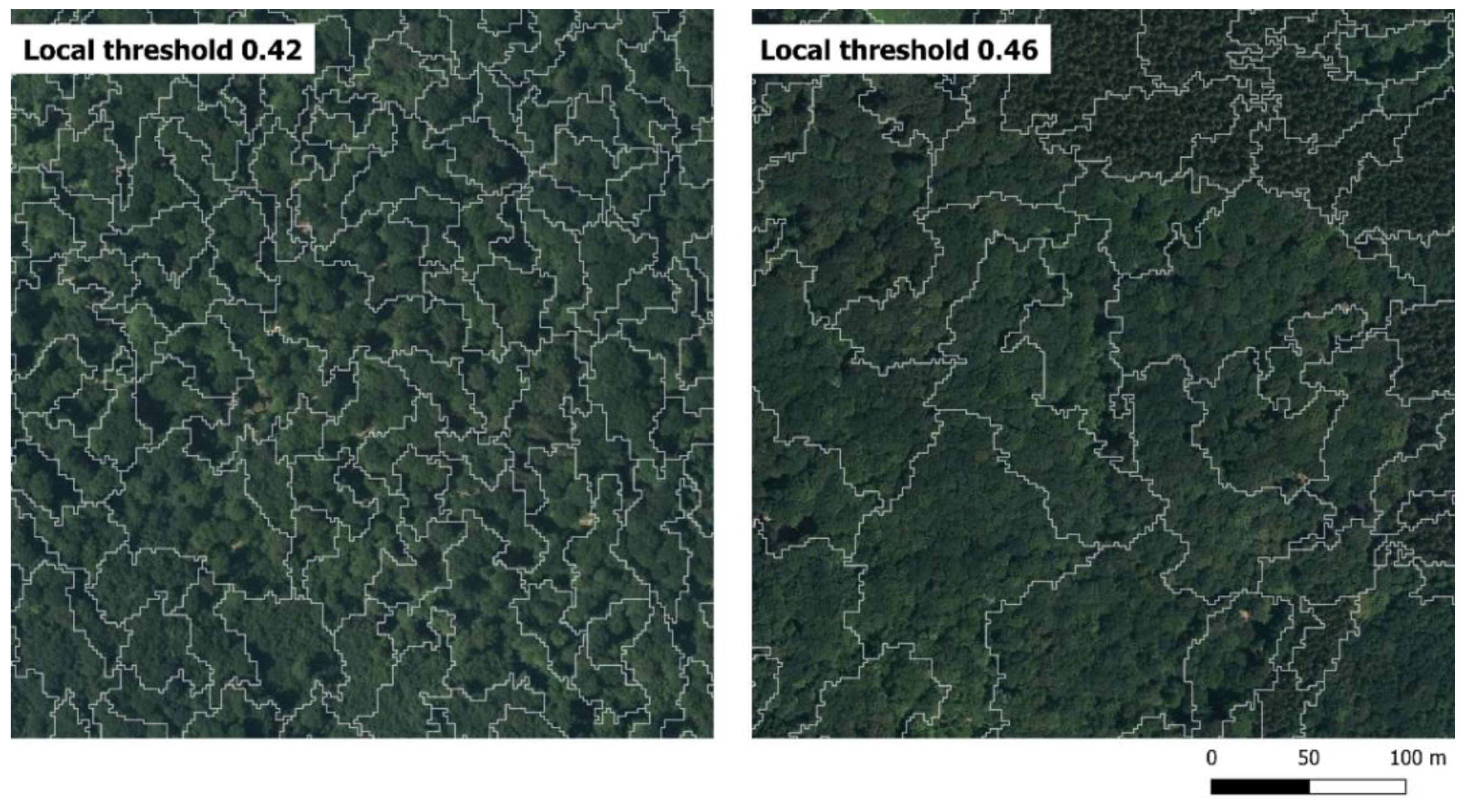

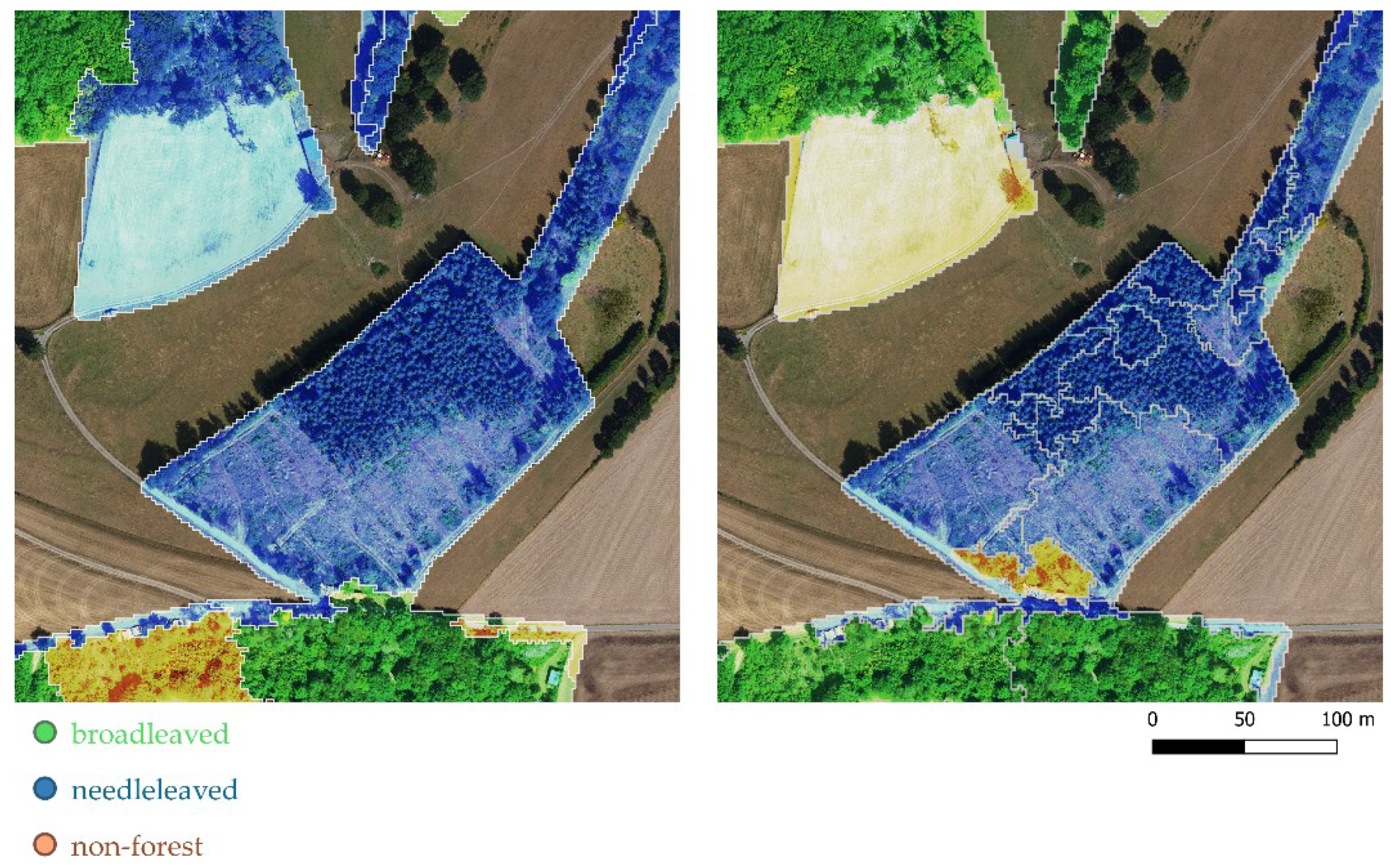


| Class | ||||
|---|---|---|---|---|
| Broadleaved | Needleleaved | Non-Forest | ||
| Sample Size | 166 | 203 | 22 | |
| Minimum (ha) | 0.09 | 0.05 | 0.05 | |
| Maximum (ha) | 27.20 | 8.41 | 0.54 | |
| Mean (ha) | 2.52 | 0.71 | 0.24 | |
| Examples | Minimum | 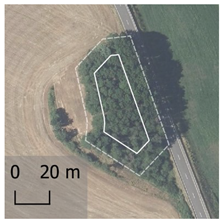 |  |  |
| Superimposed Sentinel-2 pixels | 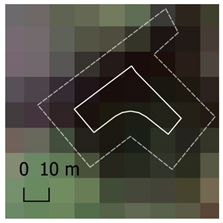 | |||
| Maximum | 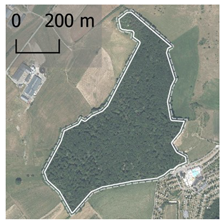 | 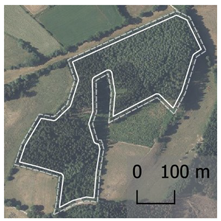 | 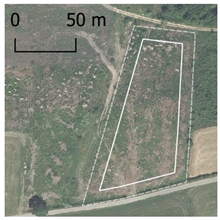 | |
| Scene | Sensor | Acquisition Date |
|---|---|---|
| S1 | Sentinel-2 A | 2020 March 28 |
| S2 | Sentinel-2 A | 2020 April 7 |
| S3 | Sentinel-2 B | 2020 April 22 |
| S4 | Sentinel-2 A | 2020 May 7 |
| S5 | Sentinel-2 A | 2020 May 17 |
| S6 | Sentinel-2 A | 2020 May 27 |
| S7 | Sentinel-2 B | 2020 July 31 |
| S8 | Sentinel-2 A | 2020 August 5 |
| Combinations | OAA | |||||
|---|---|---|---|---|---|---|
| Sentinel-2 Scene(s) | Index Time Series | Aerial Imagery | Texture | |||
| S3 (10) | 88.3% | |||||
| S8 (10) | 84.9% | |||||
| S3 (10) | S4 (10) | 89.1% | ||||
| S3 (10) | S4 (10) | S5 (10) | 89.3% | |||
| All (80) | 88.9% | |||||
| SR (8) | 89.4% | |||||
| CIR (4) | 73.0% | |||||
| CIR (4) | T (13) | 74.5% | ||||
| SR (8) | T (13) | 89.4% | ||||
| Reference | ||||
|---|---|---|---|---|
| Needleleaved | Broadleaved | Non-Forest | ||
| Prediction | Needleleaved | 5208 | 864 | 114 |
| Broadleaved | 1697 | 25423 | 389 | |
| Non-forest | 347 | 275 | 345 | |
| OAA = 89.4 | PAc | 71.8 | 95.7 | 40.7 |
| CAA = 69.4 | UAc | 84.2 | 92.4 | 35.7 |
| Q = 3.1 | qc | 3.1 | 2.7 | 0.3 |
| A = 7.5 | ac | 5.6 | 6.6 | 2.9 |
Publisher’s Note: MDPI stays neutral with regard to jurisdictional claims in published maps and institutional affiliations. |
© 2022 by the authors. Licensee MDPI, Basel, Switzerland. This article is an open access article distributed under the terms and conditions of the Creative Commons Attribution (CC BY) license (https://creativecommons.org/licenses/by/4.0/).
Share and Cite
Brauchler, M.; Stoffels, J.; Nink, S. Extension of an Open GEOBIA Framework for Spatially Explicit Forest Stratification with Sentinel-2. Remote Sens. 2022, 14, 727. https://doi.org/10.3390/rs14030727
Brauchler M, Stoffels J, Nink S. Extension of an Open GEOBIA Framework for Spatially Explicit Forest Stratification with Sentinel-2. Remote Sensing. 2022; 14(3):727. https://doi.org/10.3390/rs14030727
Chicago/Turabian StyleBrauchler, Melanie, Johannes Stoffels, and Sascha Nink. 2022. "Extension of an Open GEOBIA Framework for Spatially Explicit Forest Stratification with Sentinel-2" Remote Sensing 14, no. 3: 727. https://doi.org/10.3390/rs14030727
APA StyleBrauchler, M., Stoffels, J., & Nink, S. (2022). Extension of an Open GEOBIA Framework for Spatially Explicit Forest Stratification with Sentinel-2. Remote Sensing, 14(3), 727. https://doi.org/10.3390/rs14030727







